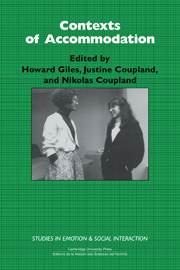Book contents
- Frontmatter
- Contents
- List of contributors
- 1 Accommodation theory: Communication, context, and consequence
- 2 Audience accommodation in the mass media
- 3 Accommodation on trial: Processes of communicative accommodation in courtroom interaction
- 4 Accommodation in medical consultations
- 5 Accommodation and mental disability
- 6 Accommodation in therapy
- 7 Accommodation in native-nonnative interactions: Going beyond the “what” to the “why” in second-language research
- 8 Interethnic accommodation: The role of norms
- 9 Organizational communication and accommodation: Toward some conceptual and empirical links
- Index
6 - Accommodation in therapy
Published online by Cambridge University Press: 18 March 2010
- Frontmatter
- Contents
- List of contributors
- 1 Accommodation theory: Communication, context, and consequence
- 2 Audience accommodation in the mass media
- 3 Accommodation on trial: Processes of communicative accommodation in courtroom interaction
- 4 Accommodation in medical consultations
- 5 Accommodation and mental disability
- 6 Accommodation in therapy
- 7 Accommodation in native-nonnative interactions: Going beyond the “what” to the “why” in second-language research
- 8 Interethnic accommodation: The role of norms
- 9 Organizational communication and accommodation: Toward some conceptual and empirical links
- Index
Summary
Introduction
Support for the original statement of speech accommodation theory (SAT) (Giles 1973) has been amply provided by experimental studies on intercultural convergence of general speech phenomena, such as language choice, accent, and speech rate (Bourhis and Giles 1977; Bourhis et al. 1979). However, recent challenges to the theory to (1) achieve more precision in detailing specific linguistic features involved in convergence or divergence (Coupland 1984; Thakerar, Giles, and Cheshire 1982; Trudgill, 1981, 1986), (2) apply to style shifting evidenced in intracultural as well as intercultural accommodation of speech between speakers of unequal status (Putnam and Street 1984), and (3) account for cooperative encounters in natural settings (Coupland 1984) have resulted in further refinement of the theory about language adaptation in response to interlocutors. Increasingly, accommodation theory is becoming concerned with the socially constituted nature of language behavior.
In light of these advances, the central aims of this chapter are to expand the range of naturally occurring settings for which information is available and to offer a close linguistic analysis of accommodated speech in the natural setting of psychotherapy. At the same time, the chapter offers methodological criticism and suggestions for innovations that may result in a clearer understanding of accommodative processes.
The setting to be examined, psychotherapy, is a highly focused dyadic experience between a client and a trained psychotherapist. Paradoxically, in psychotherapy, language serves both as the method of diagnosis and as the medium of treatment. Relatively little is known about the processes involved in the interaction because the speech event has emerged only in the twentieth century.
- Type
- Chapter
- Information
- Contexts of AccommodationDevelopments in Applied Sociolinguistics, pp. 187 - 222Publisher: Cambridge University PressPrint publication year: 1991
- 15
- Cited by



